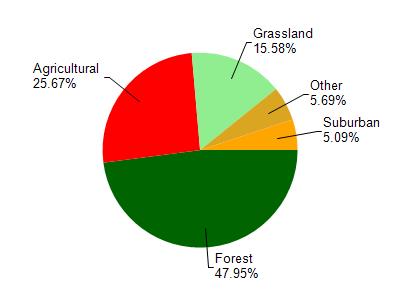Monroe
Yes
No
No
Fish and Aquatic Life
Overview
Sand Creek is a small spring-fed stream located in southwestern Monroe County. It flows in a northwesterly direction for approximately 1.4 miles before reaching the Little La Crosse River near Leon. This stream drains moderately steep forested hills and agricultural lands and has a gradient of 28 feet per mile. Sand Creek is a Class III trout stream for its entire length.
The most recent survey, completed in 1973, documented cool, clear water with a stream bottom comprised predominantly of sand with small amounts of silt, gravel, rubble and detritus. Bank cover consisted mainly of upland hardwoods with lesser amounts of swamp hardwoods; however, excessive livestock grazing of streambanks was contributing sediment to Sand Creek. In-stream cover for fish was scarce. Brook trout and several forage fish species were present but in low abundance. The Sand Creek fishery would benefit from stable streambanks and the addition of in-stream habitat structures. A fish and habitat survey of Sand Creek should be conducted to document its current status. There are no DNR stocking records for Sand Creek. Access is possible from one road crossing.
Date 2002
Author Aquatic Biologist
Condition
Wisconsin has over 84,000 miles of streams, 15,000 lakes and milllions of acres of wetlands. Assessing the condition of this vast amount of water is challenging. The state's water monitoring program uses a media-based, cross-program approach to analyze water condition. An updated monitoring strategy (2015-2020) is now available. Compliance with Clean Water Act fishable, swimmable standards are located in the Executive Summary of Water Condition in 2018. See also the 'monitoring and projects' tab.
Management Goals
Wisconsin's Water Quality Standards provide qualitative and quantitative goals for waters that are protective of Fishable, Swimmable conditions [Learn more]. Waters that do not meet water quality standards are considered impaired and restoration actions are planned and carried out until the water is once again fishable and swimmable
Management goals can include creation or implementation of a Total Maximum Daily Load analysis, a Nine Key Element Plan, or other restoration work, education and outreach and more. If specific recommendations exist for this water, they will be displayed below online.
Monitoring
Monitoring the condition of a river, stream, or lake includes gathering physical, chemical, biological, and habitat data. Comprehensive studies often gather all these parameters in great detail, while lighter assessment events will involve sampling physical, chemical and biological data such as macroinvertebrates. Aquatic macroinvertebrates and fish communities integrate watershed or catchment condition, providing great insight into overall ecosystem health. Chemical and habitat parameters tell researchers more about human induced problems including contaminated runoff, point source dischargers, or habitat issues that foster or limit the potential of aquatic communities to thrive in a given area. Wisconsin's Water Monitoring Strategy was recenty updated.
Grants and Management Projects
| Project Name (Click for Details) | Year Started |
|---|
|
|
Monitoring Projects
| WBIC | Official Waterbody Name | Station ID | Station Name | Earliest Fieldwork Date | Latest Fieldwork Date | View Station | View Data |
|---|
| 1656000 | Sand Creek | 10017359 | Sand Creek (Little Lax Trib) St. 1 Mouth Upstream | | | Map | Data |
| 1656000 | Sand Creek | 10017360 | Sand Creek (Little Lax Trib) St. 2 Jamboree Rd. Crossing | 8/29/2022 | 8/29/2022 | Map | Data |
|

Watershed Characteristics
Sand Creek is located in the Little La Crosse River watershed which is 240.79 mi². Land use in the watershed is primarily forest (48%), agricultural (25.70%) and a mix of grassland (15.60%) and other uses (10.80%). This watershed has 445.88 stream miles, 114.59 lake acres and 5,439.88 wetland acres.
Nonpoint Source Characteristics
This watershed is ranked High for runoff impacts on streams, Not Ranked for runoff impacts on lakes and Low for runoff impacts on groundwater and therefore has an overall rank of Low. This value can be used in ranking the watershed or individual waterbodies for grant funding under state and county programs.However, all waters are affected by diffuse pollutant sources regardless of initial water quality. Applications for specific runoff projects under state or county grant programs may be pursued. For more information, go to surface water program grants.